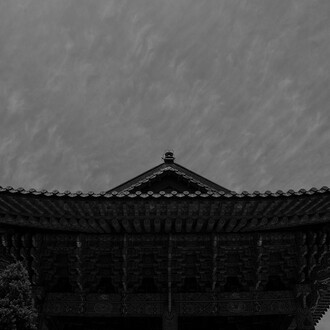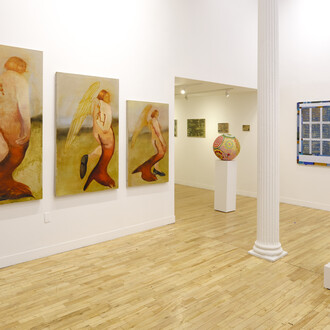Kate Oh Gallery is delighted to present a two-person show “Figures”, featuring works by Marlon Forrester, Erin Hinz. Organized by independent curator Pema Rinzin, the show will explore the idea of different connotations of figures: Hinzs’s artwork depicts physical body shapes to study physiological and psychological aspects of performance, emotions, and security. Forrester’s work consists of multiple conceptual body images in an attempt to describe the cultural and social notions of black figure.
Marlon Forrester reflects on the exploitation implicit in the simultaneous apotheosis and fear of the muscular black figure in contemporary America. Geometric lines become cells or crossways taken from the actual basketball court that hold flatness parenthetically within, while the other perspectival lines mimic Western perspective, itself a mimetic production of space. The use of linear perspective and a strongly patterned surface with the number 23 embedded within producing a kind of dissonant harmony providing the backdrop for the ambulatory bodies that populate his paintings.
These formal aspects, simultaneously real and unreal, mirror the interaction between black masculinity as a symbol and of the artist’s actual body, and geometry found within the basketball court. Their intricacy necessitates working in close proximity to the canvas with only a few inches separating the artist from the surface. Hence we, as spectators, are brought close to both a conceptual body he is attempting to disrupt as well as to his own body as an act of self-creation in each painting.
The forms in Hinz’s paintings are meant to deconstruct the experience of being in a body. Rather than complete bodies, body parts exist as singular beings. Sometimes full of agency,
legs have faces, often dopily smiling at the viewer or gazing at themselves in a mirror. Or, in contrast, the body parts might be lifeless, pieces of meat freshly severed and resting on dinner plates or vanity tables surrounded by cosmetics as full figures look upon them. These different states of the forms are intended to describe the physiological and psychological notions of performance, pleasure, pain, danger, and safety.
In previous paintings, Hinz constructed forms out of seamlessly attached idealized female body parts. For instance, a giant toe might be attached to a pair of legs. Over time the beautiful but grotesque forms have slowly evolved (or dissolved) into separate less perfect shapes who have gained autonomy through their ugliness.
Through references to the domestic Hinz explores ideas about gender, health and the public and private spheres. Using a Candy Land palette, bedrooms and bathrooms overgrown with foliage depict the domestic as a safe and wildly free space for the forms to examine themselves.
















